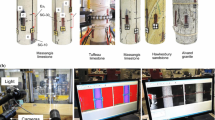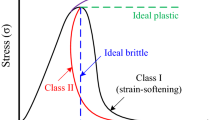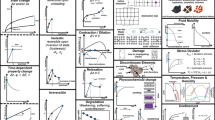Abstract
The rock mass behavior can be studied using the complete stress–strain curve obtained from laboratory tests. To capture the complete curve and prevent violent failure, a stiff servo-assisted testing machine is required. Mainly due to the challenges in performing these tests and the fact that rock mass behavior is typically studied prior to failure, there is a lot of uncertainty in post-peak behavior. In fact, several studies have been developed to estimate pre-peak mechanical properties based on geological characteristics such as grain size and mineral composition but not to estimate post-peak properties. This study uses geological characteristics, index test results and pre-peak mechanical properties to estimate post-peak properties. For this purpose, uniaxial compression tests were conducted on ten different lithologies of brittle rocks. The procedure applied is based on standardized recommendation, photography techniques at hand scale have been used while for geological analysis. Three models were adjusted. The first model predicts UCS using the Dynamic Young’s modulus, the second predicts the likelihood of capturing the post-peak behavior, and the third is a multivariable model that estimates the drop modulus considering mechanical properties and porosity. Regarding geological analyses at the scale of photography, no conclusive information was found. Literature suggests that porosity is an important property for estimating pre-peak mechanical properties, and this study provides evidence that porosity can be helpful in predicting the drop modulus. It is recommended to strengthen the models with additional tests, reduce biases associated with LVDTs location and the representativeness of certain lithologies compared to others, and evaluate other testing methodologies for performing tests faster.
Highlights
-
Post-peak tests in very brittle rocks require a servo-testing machine and specific methodologies that reduce testing time while avoiding uncontrolled failure.
-
Three models are proposed for predicting UCS, the likelihood of capturing successfully the post-peak and drop modulus as a function of mechanical and index properties.
-
Non-destructive P-S wave velocities test is a useful alternative to have a preliminary estimation of UCS to define the stages for carrying out post-peak tests.
-
Results indicate that UCS plays a role in predicting the likelihood of capturing successfully the post-peak at laboratory when testing brittle rocks in a given laboratory.
-
UCS, Young Modulus and porosity can be used to estimate drop modulus in very brittle rocks.















Similar content being viewed by others
Data Availability
All data is provided as figures and tables in the manuscript.
References
Arzúa J, Alejano LR, Walton G (2014) Strength and dilation of jointed granite specimens in servo-controlled triaxial tests. Int J Rock Mech Min Sci 69:93–104. https://doi.org/10.1016/j.ijrmms.2014.04.001
Askaripour M, Saeidi A, Mercier-Langevin P, Rouleau A (2022) A review of relationship between texture characteristic and mechanical properties of rock. Geotechnics 2:262–296. https://doi.org/10.3390/geotechnics2010012
ASTM Standard (2018) C97/C97M-18: Standard test methods for absorption and bulk specific gravity of dimension stone. https://doi.org/10.1520/C0097_C0097M-18
ASTM Standard (2014) D7012-14: Standard test methods for compressive strength and elastic moduli of intact rock core specimens under varying states of stress and temperatures. https://doi.org/10.1520/D7012-14
ASTM Standard (2020) E494–20: Standard practice for measuring ultrasonic velocity in materials by comparative pulse-echo method. https://doi.org/10.1520/E0494-20
Aydin A (2014) Upgraded ISRM suggested method for determining sound velocity by ultrasonic pulse transmission technique. Rock Mech Rock Eng 47:255–259. https://doi.org/10.1007/s00603-013-0454-z
Bieniawski ZT, Bernede MJ (1979) Suggested methods for determining the uniaxial compressive strength and deformability of rock materials: part 1 suggested method for determining deformability of rock materials in uniaxial compression. Int J Rock Mech Mining Sci Geomech Abstr 16(2):138–140. https://doi.org/10.1016/0148-9062(79)91451-7
Brace WF (1961) Dependence of fracture strength of rocks on grain size. In: Proceedings of the 4th US Symposium on Rock Mechanics (USRMS), University Park, PA, USA, 30 March–1 April: 76: 99–103
Bukowska M (2013) Post-peak failure modulus in problems of mining geo-mechanics. J Min Sci 49:731–740. https://doi.org/10.1134/S1062739149050067
Cai M, Hou PY, Zhang XW, Feng XT (2021) Post-peak stress–strain curves of brittle hard rocks under axial-strain-controlled loading. Int J Rock Mech Min Sci 147:104921. https://doi.org/10.1016/j.ijrmms.2021.104921
Cvitanović NŠ, Nikolić M, Ibrahimbegović A (2015) Influence of specimen shape deviations on uniaxial compressive strength of limestone and similar rocks. Int J Rock Mech Min Sci 80:357–372. https://doi.org/10.1016/j.ijrmms.2015.10.008
Czinder B, Török Á (2021) Strength and abrasive properties of andesite: relationships between strength parameters measured on cylindrical test specimens and micro-Deval values—a tool for durability assessment. Bull Eng Geol Environ 80:8871–8889. https://doi.org/10.1007/s10064-020-01983-9
Dipova N (2017) Determining the grain size distribution of granular soils using image analysis. Acta Geotechnica Slovenica 14(1):29–37
Entwisle DC, Hobbs PRN, Jones LD, Gunn D, Raines MG (2005) The relationships between effective porosity, uniaxial compressive strength and sonic velocity of intact borrowdale volcanic group core samples from sellafield. Geotech Geol Eng 23:793–809. https://doi.org/10.1007/s10706-004-2143-x
Fairhurst CE, Hudson JA (1999) Draft ISRM suggested method for the complete stress-strain curve for intact rock in uniaxial compression. Int J Rock Mech Min Sci 36(3):279–289. https://doi.org/10.1016/S0148-9062(99)00006-6
Gavasci AT (1989) Textures of igneous rocks. Petrology. Encyclopedia of Earth Science. Springer, Boston, MA. https://doi.org/10.1007/0-387-30845-8_240
Geranmayeh Vaneghi R, Saberhosseini SE, Dyskin AV, Thoeni K, Sharifzadeh M, Sarmadivaleh M (2021) Sources of variability in laboratory rock test results. J Rock Mech GeotechEng 13(5):985–1001. https://doi.org/10.1016/j.jrmge.2021.03.007
Heidari M, Khanlari GR, Torabi-Kaveh M, Kargarian S, Saneie S (2014) Effect of porosity on rock brittleness. Rock Mech Rock Eng 47:785–790. https://doi.org/10.1007/s00603-013-0400-0
Heidbach O, Tingay M, Barth A, Reinecker J, Kurfeß D, Müller B (2010) Global crustal stress pattern based on the world stress map database release 2008. Tectonophysics 482(1–4):3–15. https://doi.org/10.1016/j.tecto.2009.07.023
Higgins MD (2006) Quantitative textural measurements in igneous and metamorphic petrology. Cambridge University Press, Cambridge, pp 7–9
Hudson JA, Crouch SL, Fairhurst C (1972) Soft, stiff and servo-controlled testing machines: a review with reference to rock failure. Eng Geol 6(3):155–189. https://doi.org/10.1016/0013-7952(72)90001-4
Mendes FM, Aires-Barros L, Rodrigues FP (1966) The use of modal analysis in the mechanical characterization of rock masses. In: Proceedings of the 1st ISRM Congress, Lisbon, Portugal, 25 September–1 October
Meng F, Zhou H, Zhang C, Xu R, Lu J (2015) Evaluation methodology of brittleness of rock based on post-peak stress–strain curves. Rock Mech Rock Eng 48:1787–1805. https://doi.org/10.1007/s00603-014-0694-6
Meng F, Wong LNY, Zhou H (2021) Rock brittleness indices and their applications to different fields of rock engineering: a review. J Rock Mech Geotech Eng 13(1):221–247. https://doi.org/10.1016/j.jrmge.2020.06.008
Onodera TF, Asoka Kumara HM (1980) Relation between texture and mechanical properties of crystalline rocks. Bull Int Assoc Eng Geol 22:173–177
Palchik V, Hatzor Y (2004) The influence of porosity on tensile and compressive strength of porous chalks. Rock Mech Rock Eng 37:331–341. https://doi.org/10.1007/s00603-003-0020-1
Paredes I (2022) Adaptación de metodología basada en la aplicación de cargas cíclicas para la obtención de curva completa esfuerzo-deformación. Universidad de Santiago de Chile, Memoria de título de Ingeniero Civil en Minas
Reichmuth DR (1967) Point load testing of brittle materials to determine tensile strength and relative brittleness. In: ARMA US Rock Mechanics/Geomechanics Symposium. pp. ARMA-67
Rummel F, Fairhurst C (1970) Determination of the post-failure behavior of brittle rock using a servo-controlled testing machine. Rock Mech 2:189–204. https://doi.org/10.1007/BF01245574
Saeidi O, Geranmayeh V, Gholami R, Torabi S (2014) A modified failure criterion for transversely isotropic rocks. Geosci Front 5:215–225. https://doi.org/10.1016/j.gsf.2013.05.005
Salinas E (2018) Análisis de Propiedades Geotécnicas de Algunas Rocas Comunes en Chile. Memoria para optar al título de Geólogo, Universidad de Chile https://repositorio.uchile.cl/handle/2250/169948
Singh SP, Sharma A, Wei L (2008) Alleviation of rock bursts by identifying burst-prone mine workings. In: Proceedings of the 27th International Conference on Ground Control in Mining, Morgantown, WV, USA (pp. 29–31)
Szwedzicki T (2003) Rock mass behaviour prior to failure. Int J Rock Mech Min Sci 40(4):573–584. https://doi.org/10.1016/S1365-1609(03)00023-6
Szwedzicki T (2018) Chapter 9: post-failure rock mass behaviour. Rock mass response to mining activities: inferring large-scale rock mass failure. CRC Press, Boca Raton. https://doi.org/10.1201/9781315112336
Tsidzi KE (1997) Propagation characteristics of ultrasonic waves in foliated rocks. Assoc Eng Geol 56:103–113
Tugrul A, Zarif IH (1999) Correlation of mineralogical and textural characteristics with engineering properties of selected granitic rocks from Turkey. Eng Geol 51:303–317. https://doi.org/10.1016/j.-.06.001
Tutluoğlu L, Öge İF, Karpuz C (2015) Relationship between pre-failure and post-failure mechanical properties of rock material of different origin. Rock Mech Rock Eng 48:121–141. https://doi.org/10.1007/s00603-014-0549-1
Ündül Ö (2016) Assessment of mineralogical and petrographic factors affecting petro-physical properties, strength and cracking processes of volcanic rocks. Eng Geol 210:10–22. https://doi.org/10.1016/j.enggeo.2016.06.001
Velásquez J (2022) Estudio de la Influencia de la Litología en la Respuesta Post-Peak en Muestras de Origen Ígneo a Escala de Laboratorio. Memoria de título de geólogo, Universidad de Chile. https://repositorio.uchile.cl/handle/2250/187258
Yilmaz NG, Karaca Z, Goktan RM, Akal C (2008) Relative brittleness characterization of some selected granitic building stones: influence of mineral grain size. Constr Build Mater 23(1):370–375. https://doi.org/10.1016/j.conbuildmat.2007.11.014
Yue X, Wen T, Gao Y, Jia W, Wang Y, Hu M (2023) Evaluation method for determining rock brittleness in consideration of plastic deformation in pre-peak and failure energy in post-peak. Appl Sci 13(23):12711. https://doi.org/10.3390/app132312711
Zhai S, Su G, Yin S, Zhao B, Yan L (2020) Rockburst characteristics of several hard brittle rocks: a true triaxial experimental study. J Rock Mech Geotech Eng 12(2):279–296. https://doi.org/10.1016/j.jrmge.2019.07.013
Zheng Z, Zheng H, Zhao J, Liu Z, Feng G, Qiu S (2023) Ductile–brittle quantitative evaluation of rock based on post-peak properties under true triaxial stress. Geomech Geophys Geo-Energ Geo-Resour 9(1):81. https://doi.org/10.1007/s40948-023-00567-7
Zúñiga C, Vallejos JA, Suzuki K, Orellana LF, Arzúa J (2020) Scale effect on the post-peak behavior in uniaxial compression in dacite samples. In: MassMin 2020-Eighth International Conference and Exhibition on Mass Mining. Virtual Conference
Acknowledgements
The authors gratefully acknowledge financial support from the basal project AFB220002 of the Advanced Mining Technology Center (AMTC), University of Chile. Special thanks to Jorge Velásquez, David Veloz, Arturo García and Flavia Polanco for their support in carrying out destructive laboratory tests, Javiera Pérez and Fernando Reveco for helping with the geological analysis, and Javier Vallejos and Lorena Burgos for their comments. Special thanks to Miguel Vera for providing samples of two lithologies and granting access to conduct non-destructive tests at the Rock Mechanics laboratory of USACH.
Funding
This work was supported by the basal project AFB220002 of the Advanced Mining Technology Center (AMTC), University of Chile.
Author information
Authors and Affiliations
Contributions
The study conception and design was proposed by Kimie Suzuki Morales and Sergio Flores. Samples were characterized and tests were performed by Sergio Flores. The first draft of the manuscript was written by Sergio Flores and Kimie Suzuki Morales and Pia Lois-Morales commented on previous versions of the manuscript. All authors read and approved the final manuscript.
Corresponding author
Ethics declarations
Conflict of interest
The authors have no financial or non-financial interests to disclose.
Additional information
Publisher's Note
Springer Nature remains neutral with regard to jurisdictional claims in published maps and institutional affiliations.
Rights and permissions
Springer Nature or its licensor (e.g. a society or other partner) holds exclusive rights to this article under a publishing agreement with the author(s) or other rightsholder(s); author self-archiving of the accepted manuscript version of this article is solely governed by the terms of such publishing agreement and applicable law.
About this article
Cite this article
Flores, S., Suzuki Morales, K. & Lois-Morales, P. Influence of Index Properties and Semi-Quantitative Geological Characteristics of Brittle Rocks on Their Post-Peak Behavior. Rock Mech Rock Eng (2024). https://doi.org/10.1007/s00603-024-03879-6
Received:
Accepted:
Published:
DOI: https://doi.org/10.1007/s00603-024-03879-6




